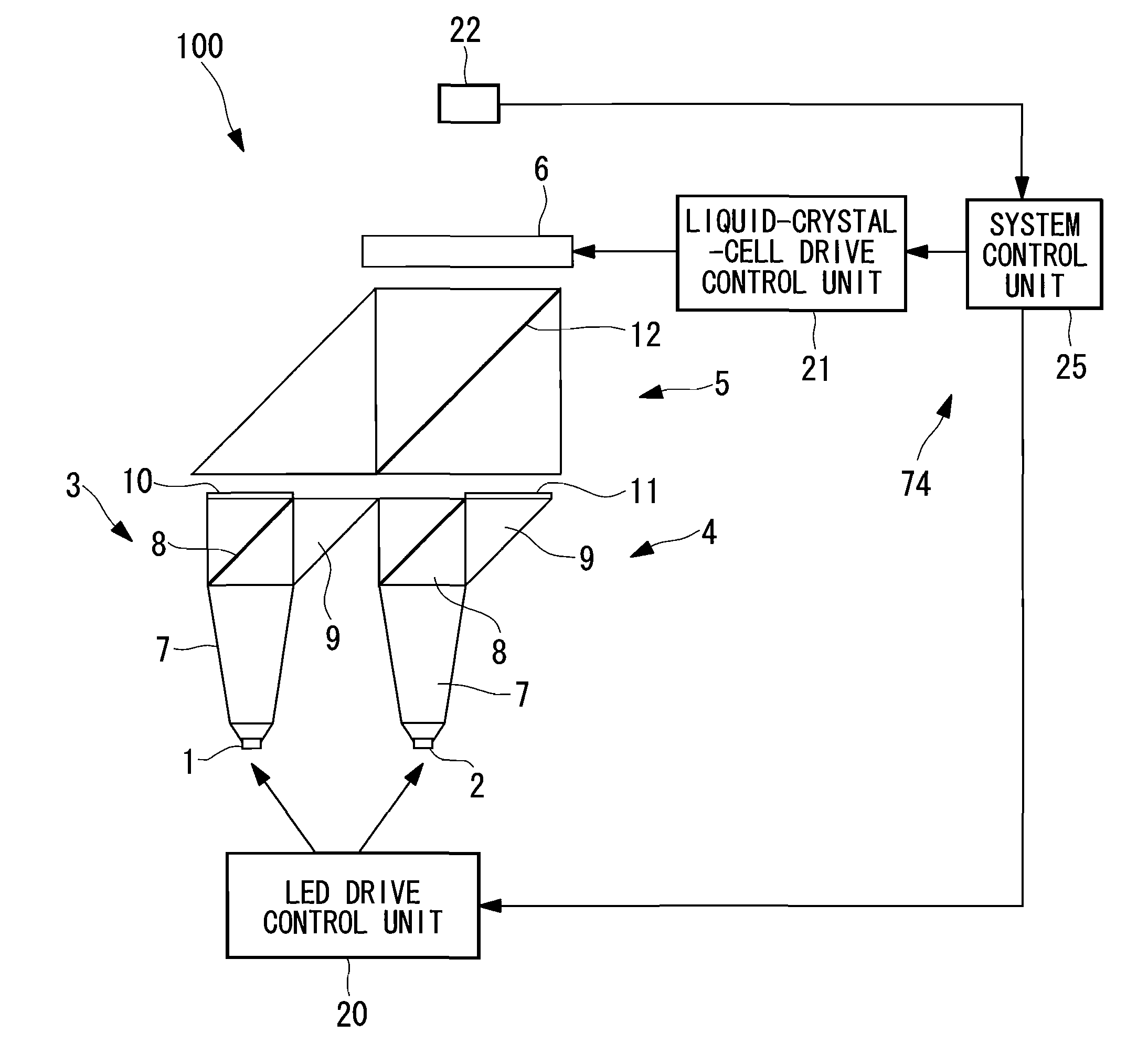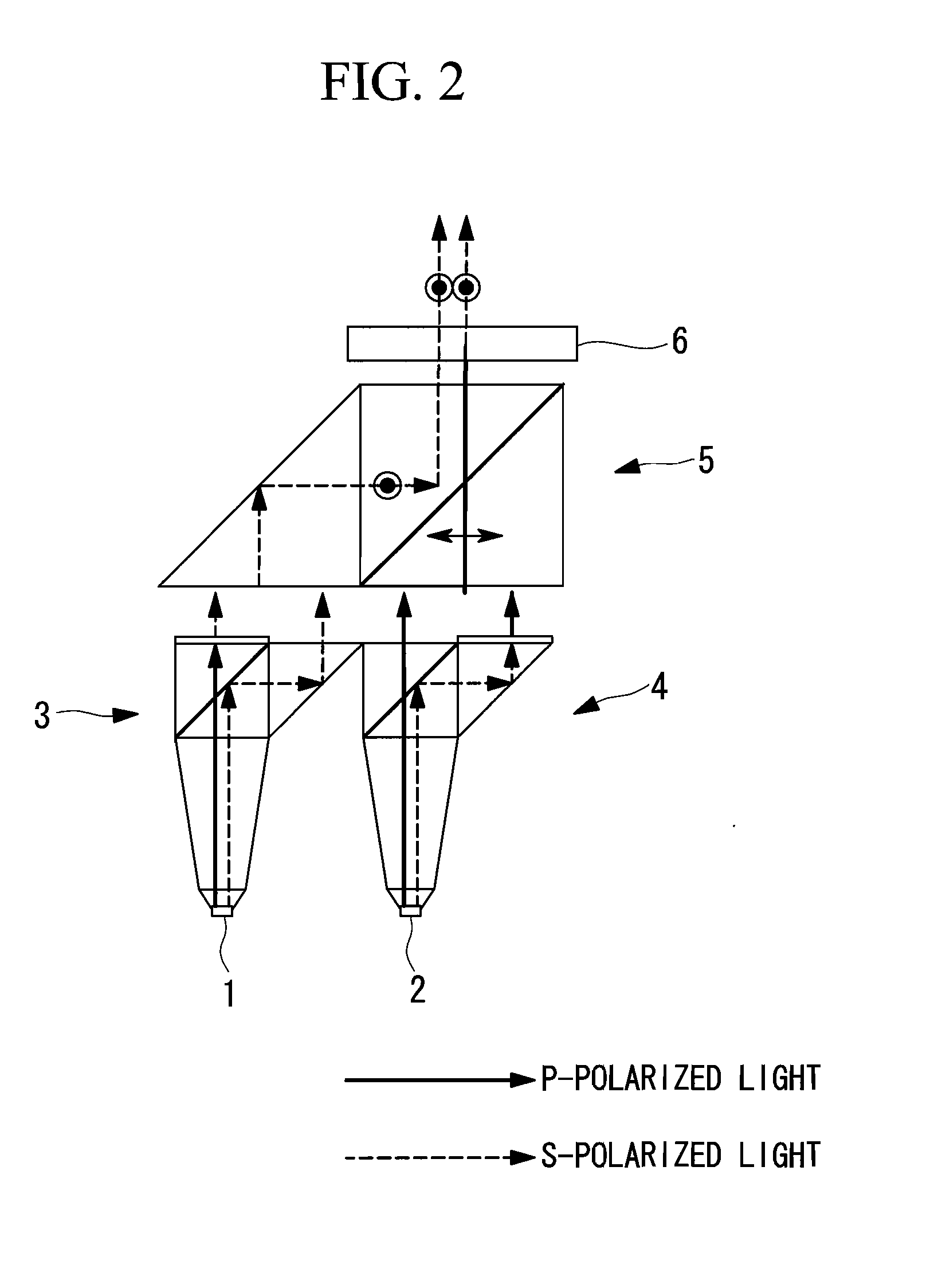Illumination apparatus and image projector using the same
a technology of illumination apparatus and image projector, which is applied in the direction of non-linear optics, instruments, printing, etc., can solve the problems of low light utilization efficiency and change in light intensity of illumination light, and achieve the effect of increasing light utilization ratio and reducing the change in illumination light intensity
- Summary
- Abstract
- Description
- Claims
- Application Information
AI Technical Summary
Benefits of technology
Problems solved by technology
Method used
Image
Examples
first embodiment
[0085]FIG. 1 illustrates, in outline, the structure of an illumination apparatus 100 according to a first embodiment of the present invention. FIG. 2 illustrates the polarization states of the illumination apparatus 100 illustrated in FIG. 1.
[0086]As shown in FIG. 1, the illumination apparatus 100 according to this embodiment includes a first light-emitting diode (LED: first light source unit) 1, a second LED (second light source unit) 2, a polarization converter unit (first polarization converter unit) 3 that aligns the polarization directions of the illumination light beams emitted from the first LED 1 in a first polarization direction, a polarization converter unit (second polarization converter unit) 4 that matches the polarization directions of the illumination light beams emitted from the second LED 2 to a second polarization orthogonal to the first polarization direction, a light-combining unit 5 that combines the light outputted from the polarization converter unit 3 and the...
first modification
[0122]Next a modification of the above-described illumination apparatus 100 will be described.
[0123]FIG. 10 illustrates a first modification of the illumination apparatus 100. In FIG. 10, instead of the tapered rods 7 shown in FIG. 1, paraboloidal reflectors 31 are provided on backsides of the first LED 1 and the second LED 2 so as to increase the degree of collimation. Unlike the arrangement shown in FIG. 1 in which the first LED 1 and the second LED 2 are arranged in a row, the first LED 1 and the second LED 2 are arranged so that their optical axes are orthogonal to each other. In this way, light-guiding units such as the triangular prism 9 shown in FIG. 1 are not required. Accordingly, the structure of the illumination apparatus 100 can be simplified.
second modification
[0124]FIG. 11 illustrates a second modification of the illumination apparatus 100.
[0125]In the second modification, instead of the tapered rods 7 shown in FIG. 1, compound parabolic concentrators (CPCs) 32 are employed. The degree of collimation of the light from the first LED 1 and the second LED 2 can be increased also by using such CPCs 32. Furthermore, according to this modification, by disposing two polarization beam splitters 8a and 8b at the emission side of each of the CPCs 32, light emitted from the LEDs 1 and 2 can be guided in four optical paths. More specifically, the polarization beam splitters 8a and 8b are disposed at a 45-degree angle to the optical axes of the first LED 1 and the second LED 2 and are disposed such that the surfaces of the polarization splitting films intersect at a right angle. Light reflected at the polarization beam splitters 8a and 8b is incident on the triangular prism and is guided to the light-combining unit 5 via an optical path parallel to t...
PUM
| Property | Measurement | Unit |
|---|---|---|
| wavelength | aaaaa | aaaaa |
| luminance | aaaaa | aaaaa |
| light intensity | aaaaa | aaaaa |
Abstract
Description
Claims
Application Information
 Login to View More
Login to View More - R&D
- Intellectual Property
- Life Sciences
- Materials
- Tech Scout
- Unparalleled Data Quality
- Higher Quality Content
- 60% Fewer Hallucinations
Browse by: Latest US Patents, China's latest patents, Technical Efficacy Thesaurus, Application Domain, Technology Topic, Popular Technical Reports.
© 2025 PatSnap. All rights reserved.Legal|Privacy policy|Modern Slavery Act Transparency Statement|Sitemap|About US| Contact US: help@patsnap.com



